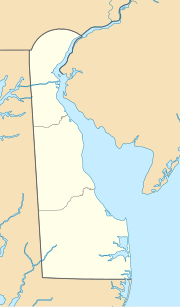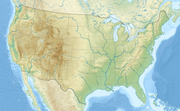| Murderkill River | |
|---|---|
 The Murderkill River downstream of Killens Pond in 2006 | |
| Location | |
| Country | United States |
| State | Delaware |
| County | Kent |
| Physical characteristics | |
| Source | |
| • location | near Felton |
| • coordinates | 39°01′03″N 75°35′31″W / 39.01750°N 75.59194°W[1] |
| Mouth | Delaware Bay |
• location | Bowers |
• coordinates | 39°03′30″N 75°23′48″W / 39.05833°N 75.39667°W[1] |
• elevation | 3 ft (0.91 m)[1] |
| Length | 22 mi (35 km)[2] |
| Basin size | 106 sq mi (270 km2)[3] |
| Discharge | |
| • location | mouth |
| • average | 122.8 cu ft/s (3.48 m3/s) (estimate)[4] |
| Basin features | |
| Progression | Delaware Bay → Atlantic Ocean |
| Tributaries | |
| • left | Fan Branch Spring Branch Ash Gut Spring Creek |
| • right | Beaverdam Branch Black Swamp Creek Browns Branch |
| Waterbodies | Killen Pond Coursey Pond |
The Murderkill River is a river flowing to Delaware Bay in central Delaware in the United States. It is approximately 21.7 miles (34.9 km) long[2] and drains an area of 106 square miles (270 km2) on the Atlantic Coastal Plain.
The Murderkill flows for its entire length in southern Kent County. It rises just west of Felton and flows generally east-northeastwardly, through Killen Pond[5] (site of Killens Pond State Park[6]) and Coursey Pond,[7] under Carpenters Bridge, and past Frederica to Bowers, where it enters Delaware Bay about 0.5 miles (1 km) south of the mouth of the St. Jones River.[8] The Murderkill River is tidally influenced from its mouth upstream to just past Frederica,[3] and is considered by the U.S. Army Corps of Engineers to be navigable for the lower 10 miles (16 km) of its course.[9]
According to 2002 data from the United States Environmental Protection Agency, 55% of the area of the Murderkill River's watershed is occupied by agricultural uses; 17% is forested; 14% is urban; 9% is wetland; and 2% is water.[3]
- ^ a b c Geographic Names Information System. "GNIS entry for Murderkill River (Feature ID #214364)". Retrieved 2007-01-30.
- ^ a b U.S. Geological Survey. National Hydrography Dataset high-resolution flowline data. The National Map, accessed April 1, 2011
- ^ a b c United States Environmental Protection Agency (2005). "Decision Rationale: Total Maximum Daily Load Analysis for the Murderkill River Watershed". pp. 3–4. Retrieved 2007-01-30.
- ^ United States Environmental Protection Agency. "Watershed Report: Murderkill River". WATERS GeoViewer. Archived from the original on 2021-07-23. Retrieved 2021-07-23.
- ^ Geographic Names Information System. "GNIS entry for Killen Pond (Feature ID #217871)". Retrieved 2007-01-30.
- ^ "Killens Pond State Park website". Retrieved 2007-01-30.
- ^ Geographic Names Information System. "GNIS entry for Coursey Pond (Feature ID #213834)". Retrieved 2007-01-30.
- ^ DeLorme (2004). Maryland Delaware Atlas & Gazetteer. p.52. Yarmouth, Maine: DeLorme. ISBN 0-89933-279-X.
- ^ U.S. Army Corps of Engineers, Philadelphia District. "Navigable waterways of the Philadelphia District". Archived from the original on 2007-06-28. Retrieved 2007-01-30.

